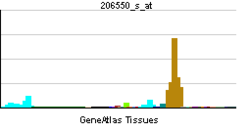- NUP155
-
Nucleoporin 155kDa Identifiers Symbols NUP155; KIAA0791; N155 External IDs OMIM: 606694 MGI: 2181182 HomoloGene: 43155 GeneCards: NUP155 Gene Gene Ontology Molecular function • transporter activity
• protein binding
• structural constituent of nuclear poreCellular component • nucleus
• nuclear envelope
• nuclear envelope
• nuclear pore
• membrane
• nuclear membraneBiological process • carbohydrate metabolic process
• nucleocytoplasmic transport
• hexose transport
• regulation of glucose transport
• protein transport
• glucose transport
• viral reproduction
• mRNA transport
• transmembrane transportSources: Amigo / QuickGO RNA expression pattern 
More reference expression data Orthologs Species Human Mouse Entrez 9631 170762 Ensembl ENSG00000113569 ENSMUSG00000022142 UniProt O75694 Q3UL43 RefSeq (mRNA) NM_004298.2 NM_133227.3 RefSeq (protein) NP_004289.1 NP_573490.3 Location (UCSC) Chr 5:
37.29 – 37.37 MbChr 15:
8.06 – 8.11 MbPubMed search [1] [2] Nuclear pore complex protein Nup155 is a protein that in humans is encoded by the NUP155 gene.[1][2]
Nucleoporins are the main components of the nuclear pore complex (NPC) of eukaryotic cells. They are involved in the bidirectional trafficking of molecules, especially mRNAs and proteins, between the nucleus and the cytoplasm. The protein encoded by this gene does not contain the typical FG repeat sequences found in most vertebrate nucleoporins. Two protein isoforms are encoded by transcript variants of this gene.[2]
Interactions
NUP155 has been shown to interact with GLE1L.[3]
References
- ^ Zhang X, Yang H, Corydon MJ, Zhang X, Pedersen S, Korenberg JR, Chen XN, Laporte J, Gregersen N, Niebuhr E, Liu G, Bolund L (Jun 1999). "Localization of a human nucleoporin 155 gene (NUP155) to the 5p13 region and cloning of its cDNA". Genomics 57 (1): 144–51. doi:10.1006/geno.1999.5741. PMID 10191094.
- ^ a b "Entrez Gene: NUP155 nucleoporin 155kDa". http://www.ncbi.nlm.nih.gov/sites/entrez?Db=gene&Cmd=ShowDetailView&TermToSearch=9631.
- ^ Rayala, Heidi J; Kendirgi Frederic, Barry Dianne M, Majerus Philip W, Wente Susan R (Feb. 2004). "The mRNA export factor human Gle1 interacts with the nuclear pore complex protein Nup155". Mol. Cell Proteomics (United States) 3 (2): 145–55. doi:10.1074/mcp.M300106-MCP200. ISSN 1535-9476. PMID 14645504.
Further reading
- Görlich D, Mattaj IW (1996). "Nucleocytoplasmic transport". Science 271 (5255): 1513–8. doi:10.1126/science.271.5255.1513. PMID 8599106.
- Nagase T, Ishikawa K, Suyama M et al. (1999). "Prediction of the coding sequences of unidentified human genes. XI. The complete sequences of 100 new cDNA clones from brain which code for large proteins in vitro". DNA Res. 5 (5): 277–86. doi:10.1093/dnares/5.5.277. PMID 9872452.
- Zhang X, Yang H, Yu J et al. (2002). "Genomic organization, transcript variants and comparative analysis of the human nucleoporin 155 (NUP155) gene". Gene 288 (1–2): 9–18. doi:10.1016/S0378-1119(02)00470-5. PMID 12034489.
- Strausberg RL, Feingold EA, Grouse LH et al. (2003). "Generation and initial analysis of more than 15,000 full-length human and mouse cDNA sequences". Proc. Natl. Acad. Sci. U.S.A. 99 (26): 16899–903. doi:10.1073/pnas.242603899. PMC 139241. PMID 12477932. http://www.pubmedcentral.nih.gov/articlerender.fcgi?tool=pmcentrez&artid=139241.
- Rayala HJ, Kendirgi F, Barry DM et al. (2004). "The mRNA export factor human Gle1 interacts with the nuclear pore complex protein Nup155". Mol. Cell Proteomics 3 (2): 145–55. doi:10.1074/mcp.M300106-MCP200. PMID 14645504.
- Ota T, Suzuki Y, Nishikawa T et al. (2004). "Complete sequencing and characterization of 21,243 full-length human cDNAs". Nat. Genet. 36 (1): 40–5. doi:10.1038/ng1285. PMID 14702039.
- Colland F, Jacq X, Trouplin V et al. (2004). "Functional Proteomics Mapping of a Human Signaling Pathway". Genome Res. 14 (7): 1324–32. doi:10.1101/gr.2334104. PMC 442148. PMID 15231748. http://www.pubmedcentral.nih.gov/articlerender.fcgi?tool=pmcentrez&artid=442148.
- Gerhard DS, Wagner L, Feingold EA et al. (2004). "The Status, Quality, and Expansion of the NIH Full-Length cDNA Project: The Mammalian Gene Collection (MGC)". Genome Res. 14 (10B): 2121–7. doi:10.1101/gr.2596504. PMC 528928. PMID 15489334. http://www.pubmedcentral.nih.gov/articlerender.fcgi?tool=pmcentrez&artid=528928.
- Hawryluk-Gara LA, Shibuya EK, Wozniak RW (2005). "Vertebrate Nup53 Interacts with the Nuclear Lamina and Is Required for the Assembly of a Nup93-containing Complex". Mol. Biol. Cell 16 (5): 2382–94. doi:10.1091/mbc.E04-10-0857. PMC 1087243. PMID 15703211. http://www.pubmedcentral.nih.gov/articlerender.fcgi?tool=pmcentrez&artid=1087243.
- Rual JF, Venkatesan K, Hao T et al. (2005). "Towards a proteome-scale map of the human protein-protein interaction network". Nature 437 (7062): 1173–8. doi:10.1038/nature04209. PMID 16189514.
Antigens: Autoantigens Dehydrogenase Transglutaminase Nucleoporins Other Acetylcholine receptor · Actin · Apolipoprotein H · Cardiolipin · Centromere · Filaggrin(Citrullinate) · Gangliosides · Sp100 nuclear antigen · Thrombin · TopoisomeraseCategories:- Human proteins
- Chromosome 5 gene stubs
Wikimedia Foundation. 2010.
